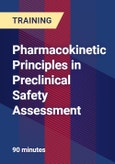Why Should You Attend:
Are you and others in your organization aware of the current best practices in understanding and optimizing pharmacokinetic properties? Poor pharmacokinetics often manifests itself during safety assessment studies, where an inability to achieve acceptable exposures can cause significant program delays and/or terminations of otherwise promising new drug candidates. This webinar will highlight the factors responsible for non-linear dose-exposure relationships that can result in expensive failed safety assessment studies. It will also describe some of the approaches used to achieve acceptable exposures through the use of non-traditional formulation and dosing methodsIt is essential that preclinical safety assessment data be interpreted in the context of drug exposures. This webinar describes the principles of pharmacokinetics, such as absorption, distribution, metabolism and excretion (ADME), as well as important concepts such as clearance, the volume of distribution and half-life. It also explores methods used to mitigate issues associated with inferior pharmacokinetic and toxicokinetic profiles, such as poor physicochemical properties-primarily solubility and permeability. Finally, it will highlight some of the in vitro and in vivo preclinical methods used to inform human dose projections.
Areas Covered in the Webinar:
Pharmacokinetic principles (ADME):- Absorption
- Distribution
- Metabolism
- Excretion
- Understanding clearance, volume of distribution and half life.
- What properties must be optimized to improve the pharmacokinetic profile of a new drug candidate.
- Balancing solubility and permeability.
- Which pharmacokinetic parameters associate with drug safety.
- Methods to achieve sufficient drug exposures during safety assessment studies.
- Predicting human doses and exposures.
Who Will Benefit:
- Medicinal chemists, toxicologists, biologists, pharmacologists, pharmacokineticists and program managers will all gain valuable insights into modern preclinical safety assessment and mitigation strategies.
- Educational levels: B.S., M.S., Ph.D.
- Best suited for drug discovery researchers in early to mid career.
- From Industries such as Pharma, Biotech, University and Research Institute Drug Discovery Programs
Speaker
Bryan NormanCourse Provider

Bryan Norman,









